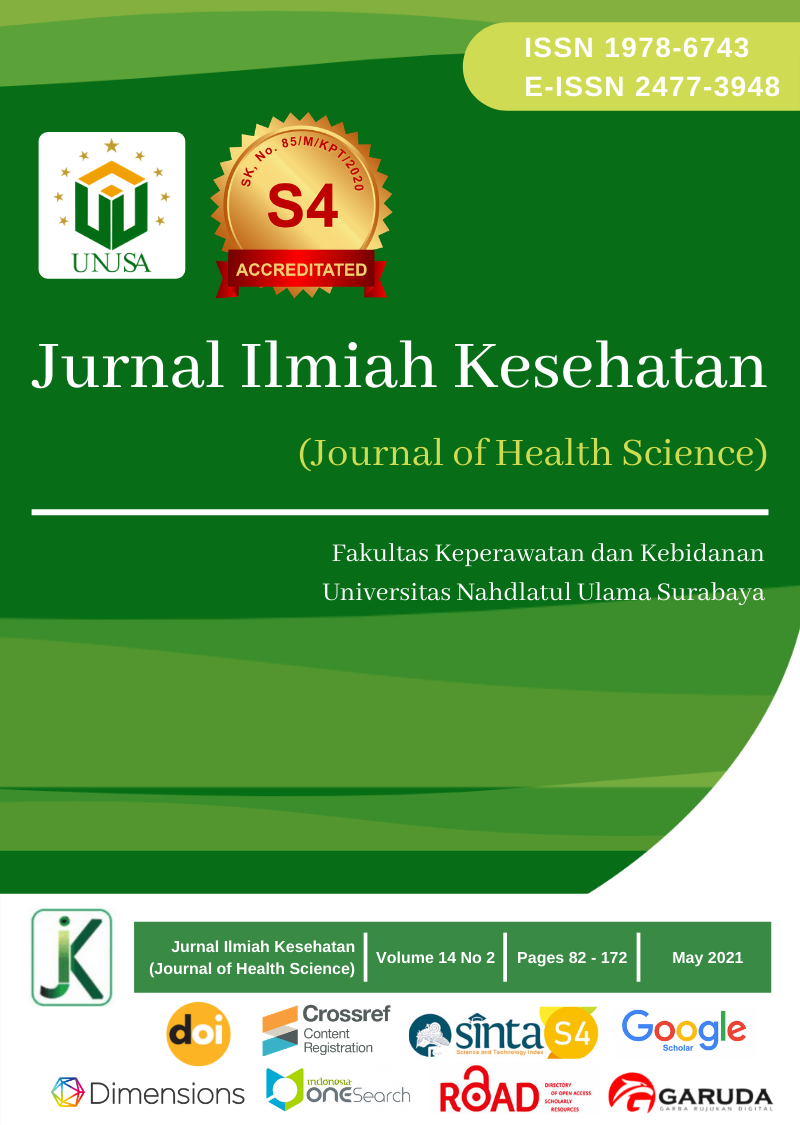Genetic Polymorphism In Individuals With Type II Diabetes Mellitus Using PCR-RAPD In Sidoarjo District
Main Article Content
Abstract
Diabetes Mellitus type II (DMT2) is a metabolic disorder which its number increases from year to year. The Control of DMT2 sufferer’s number is difficult because DMT2 is caused by genetic and environmental factors. DMT2 can worsen infectious diseases for people with other infectious diseases. This study aimed to determine the polymorphism of sufferers and non-sufferers of T2DM using PCR-RAPD method. The sample of this study consisted of 60 samples which 30 positive samples and 30 negative samples taken from several clinics in Sidoarjo district. The primer used is A 18 (5'- AGGTGACCGT-3 '). Data analysis was performed using the SPSS 16.00 program and analyzed with a Cross-sectional Chi-square with a 95% confidence level. The results of this study produced 17 bands with length of 197 bp, 239 bp, 269 bp, 319 bp, 390 bp, 530 bp, 588 bp, 686 bp, 777 bp, 972 bp, 1175 bp, 1676 bp, 2780 bp, 3843 bp, 6563 bp, 11072 bp & 18434 bp. Four of them were monomorphic and two bands showed significantly different results at 319 bp (p: 0.035) and 18434 bp (p: 0.004).there were significant differences in the resulting band at 319 (p: 0.035) bp and 18434 bp (p: 0.004). Further analysis needs to be done to confirm the genes involved.
Downloads
Article Details
Copyright (c) 2021 Miftahul Mushlih Mushlih

This work is licensed under a Creative Commons Attribution-ShareAlike 4.0 International License.
References
Al-Quwaidhi, A., Critchley, J., O′Flaherty, M., & Pearce, M. (2013). Obesity and type 2 diabetes mellitus: A complex association. Saudi Journal of Obesity, 1(2), 49. https://doi.org/10.4103/2347-2618.128627
Anggraeni, E. (2008). Random Amplified Polymorphic DNA (RAPD), Suatu Metode Analisis DNA Dalam Menjelaskan Berbagai Fenomena Biologi. (Random. Comptes Rendus - Biologies, 1(2), 57. https://doi.org/10.21082/blpn.v14n2.2008.p57-67
Chen, J., Meng, Y., Zhou, J., Zhuo, M., Ling, F., Zhang, Y., Du, H., & Wang, X. (2013). Identifying candidate genes for type 2 diabetes mellitus and obesity through gene expression profiling in multiple tissues or cells. Journal of Diabetes Research, 2013. https://doi.org/10.1155/2013/970435
Ekoe, J. M., Goldenberg, R., & Katz, P. (2018). Clinical Practice Guidelines - Screening for Diabetes in Adults Diabetes Canada. Canadian Journal of Diabetes, 42, S109–S114. https://doi.org/10.1016/j.jcjd.2017.10.013
Gray, N., Picone, G., Sloan, F., & Yashkin, A. (2016). The Relationship between BMI and Onset of Diabetes Mellitus and its Complications. South Med J., 108(1), 29–36. https://doi.org/10.14423/SMJ.0000000000000214.The
International Diabetes Federation (IDF) (2020). acecced April 2020
Karalliedde, J., & Gnudi, L. (2016). Diabetes mellitus, a complex and heterogeneous disease, and the role of insulin resistance as a determinant of diabetic kidney disease. Nephrology Dialysis Transplantation, 31(2), 206–213. https://doi.org/10.1093/ndt/gfu405
Kekenusa, G. C., Pandelaki, K., & Haroen, H. (2016). Gambaran hematologi rutin dan hubungannya dengan rerata gula darah pada pasien diabetes melitus tipe 2 di Poliklinik Endokrin RSUP Prof. Dr. R. D. Kandou Manado. E-CliniC, 4(2), 0–5. https://doi.org/10.35790/ecl.4.2.2016.14769
Kurniawaty, Evi; Yanita, B. (2016). Faktor-Faktor yang Berhubungan dengan Kejadian Diabetes Melitus Tipe II. Majority, 5(2), 27–31. Retrieved from http://juke.kedokteran.unila.ac.id/index.php/majority/article/view/1073
Loviana, R. R., Rudy, A., & Zulkarnain, E. (2015). Artikel Penelitian Faktor Risiko Terjadinya Ulkus Diabetikum pada Pasien Diabetes Mellitus yang Dirawat Jalan dan Inap di RSUP Dr . M . Jurnal Kesehatan Andalas, 4(1), 243–248.
Lyssenko, V., & Laasko, M. (2013). Genetic Screening for the Risk of Type 2 Diabetes. Diabetes Care, 36, 120–126. https://doi.org/10.2337/dcS13-2009
Mushlih, M. (2020). Difference of Red Blood Cell Count (RBC) Levels in Diabetes Mellitus Type II with Ulcers and without Ulcers. Jurnal Riset Biologi dan Aplikasinya, 2(1), 6–10.
Rahayu, P., Utomo, M., & Setiawan, M. R. (2012). Hubungan Antara Faktor Karakteristik, Hipertensi dan Obesitas dengan Kejadian Diabetes Mellitus di Rumah Sakit Umum Daerah Dr. H. Soewondo Kendal. Jurnal Kedokteran Muhammadiyah, 1(2), 26–32. Retrieved from https://jurnal.unimus.ac.id/index.php/kedokteran/article/view/1302
Sebayang, R. (2016). Hubungan Kadar Gula Darah Dengan Hipertensi Pada Pasien Diabetes Melitus Tipe 2 Di Rumah Sakit Myria Palembang. Jurnal Kesehatan, XI(2), 211–215. https://doi.org/10.15562/ism.v10i3.482
Shields, B. M., Hicks, S., Shepherd, M. H., Colclough, K., Hattersley, A. T., & Ellard, S. (2010). Maturity-onset diabetes of the young (MODY): How many cases are we missing? Diabetologia, 53(12), 2504–2508. https://doi.org/10.1007/s00125-010-1799-4
Singh, A. K., Gupta, R., Ghosh, A., & Misra, A. (2020). Diabetes in COVID-19: Prevalence, pathophysiology, prognosis and practical considerations. Diabetes and Metabolic Syndrome: Clinical Research and Reviews, 14(4), 303–310. https://doi.org/10.1016/j.dsx.2020.04.004
Tsaih, S.-W., Holl, K., Jia, S., Kaldunski, M., Tschannen, M., He, H., … Woods, L. C. S. (2014). Identification of a Novel Gene for Diabetic Traits in Rats, Mice, and Humans. Genetics, 198(1), 17–29. https://doi.org/10.1534/genetics.114.162982
WHO. (2004). Estimates for the year 2000 and projections for 2030. World Health, 27(5), 1047–1053.
Zahid, R. A., Sulaiman, B. K., & Abd, B. A. (2011). Molecular Investigation of Genetic Polymorphisms. Iraqi Journal of Cancer and Medical Genetics, 4(2), 47–54





